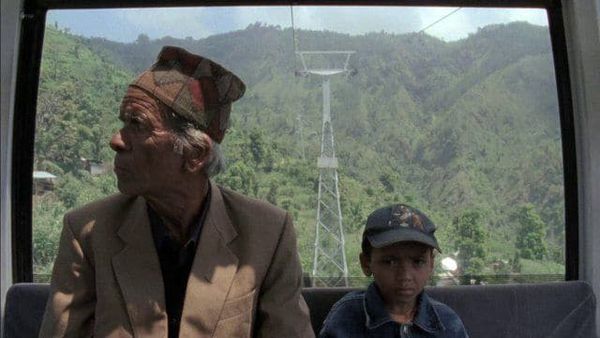Eye For Film >> Movies >> Manakamana (2013) Film Review
Manakamana
Reviewed by: Amber Wilkinson

Hop aboard a cable car high in Chitwan, Nepal, and let 11 sets of its passengers - including a good range of humanity, one kitten, one chicken and a cage of goats - take you on their journeys to and from the temple of wish-fulfilling goddess Manakamana.
Some travel in silence, others contemplate their surroundings or their destination, while two segments, showing a trip in both directions for one couple, even nod to the circle of life. All the passengers prove engrossing companions, especially when you consider that, despite the outward appearances, they are not simply travelling alone. Directors Stephanie Spray and Pacho Velez come along for each of the 10-minute rides, the low clicking of their 16mm camera audible along with the more familiar ambient sounds of a cable car and the countryside, reminding us that the artist is present.

Those who take part are listed as 'cast' and were picked to take this ride by the directors, with Velez saying that the choice of people boiled down to "do I want to look at this person for an extended period of time?". Most simply ignore the camera and the first 25 minutes pass by in silence - although the tension created in some of the trips is as much a part of the journey we are taking as anything else. We get to ask ourselves whether a trio of young men would pose so stagily for their own camera if a second point of view wasn't with them and would the women who laugh about fast-melting ice-cream be quite so self-conscious if they weren't being so obviously 'watched'.
In many ways the camera (even a 16mm one) is part and parcel of all that is new about the cable car. Several riders talk about walking to the temple when they were younger, while others express disbelief about it. This film is one of the recent projects from the Sensory Ethnographic Laboratory at Harvard University - whose other output pushing the documentary form has included the seascapes of Leviathan and shepherding of Sweetgrass.
The film, like the cable car, is suspended and moving constantly between two points - not the embarkment station, which gives way to the lives of the present or the exit gateway to the temple of the past - but a continuum of fact and construction where the distance between one and the other is hard to gauge. Each viewer is left to decide which part of the journey they are on for themselves. If you escape the cinema without immediately wanting to go and Google photos of the area the cable car passes over, so you can see the tightly packed cornfields, villages and sal forests many of the daytrippers mention, I'll be most surprised.
Reviewed on: 17 Jun 2014
















